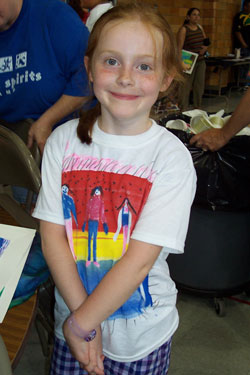Federal grant funds programs in consortium schools

Cassady Cantu, a student at St. Philip Neri School in Indianapolis, shows off a T-shirt she created during the Great Spirits Camp in the summer of 2006 sponsored by the archdiocesan Catholic Urban School Consortium and St. Joan of Arc School in Indianapolis. Volunteers in the independent program Art with a Heart helped the students create the T-shirts. (Submitted photo)
By Sean Gallagher
The teachers and administrators at the six schools in the Catholic Urban School Consortium work hard to help their students rise above the often troubled circumstances in which they live in Indianapolis.
These dedicated men and women were recently given assistance in this worthy task.
The U.S. Department of Education awarded the Archdiocese of Indianapolis a $1.9 million 21st Century Community Learning Center grant that will fund for the next three years many afterschool and summer learning programs in the consortium schools as well as St. Joan of Arc School in Indianapolis.
The schools that make up the Catholic Urban School Consortium are Central Catholic School, Holy Angels School, Holy Cross Central School, St. Andrew and St. Rita Catholic Academy and St. Anthony School, all in Indianapolis.
These schools qualified for the 21st Century Community Learning Center grant because they met a government quota for students enrolled at the school that are eligible for free or reduced-price lunches.
Whether it is in a three-week summer learning camp or in after-school programs, the grant helps the school staff have more instructional time with their students.
“This has really opened the door to be able to elongate our day with our children in an affirming, enriching environment,” said Connie Zittnan, consortium director. “And then, by adding that summer program, it opens up the number of days that we’re able to have a positive impact on our children.”
And the number of children who can be helped by the grant will likely be high. In the 2005-06 academic year, more than half the students enrolled in the consortium schools and St. Joan of Arc School participated regularly in after-school learning programs.
Because of the grant, the students in these programs will have certified teachers guiding them in their learning.
Additionally, the grant funds staffing school libraries during after-school hours. This allows students to request books and audio or visual media from the thousands available to them at their school through the Indianapolis Marion County Public Library (IMCPL).
Students also have online access through the grant to quizzes in the Accelerated Reader program that test their comprehension of more than 100,000 books.
“Our partnership with IMCPL is unique, especially for relatively small center-city Catholic schools to have access to the wealth and materials of the [library system],” said Sarah Batt, who helps oversee the use of the grant funds. “And to connect that up with Accelerated Reader just makes it even more powerful.”
Reading comprehension is a significant part of standardized tests the students take from year to year.
The 21st Century Community Learning Center grant will help the staff at the consortium schools and St. Joan of Arc School improve their students’ skills in this area by integrating their reading with other subject matter.
For example, Art with a Heart, an independent program, has been part of the three-week Great Spirits Camp since the summer camp’s inception four years ago.
This year, Art with a Heart volunteers will help the students deepen an analysis of a character in a book they will be studying by assisting them as they make a puppet of that character.
“There is all sorts of research that’s been done that [shows that] a child learns when they see, they hear, they feel, they smell—the more senses that are involved, the deeper the learning goes,” said Carol Conrad, executive director of Art with a Heart and a member of St. Simon the Apostle Parish in Indianapolis.
And, according to Zittnan, the learning that happens in the summer camp is connected to the work that students do in the academic year.
“When the children come to the summer program,” she said, “there’s meshing between what the child has been doing during the school year just ended and what they are going to be doing during the summer program.” †
